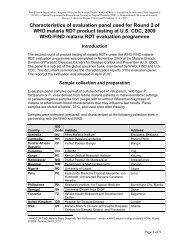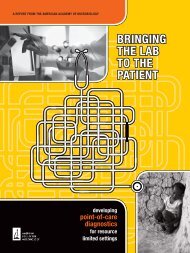Round 1 - Foundation for Innovative New Diagnostics
Round 1 - Foundation for Innovative New Diagnostics
Round 1 - Foundation for Innovative New Diagnostics
You also want an ePaper? Increase the reach of your titles
YUMPU automatically turns print PDFs into web optimized ePapers that Google loves.
5. Data management<br />
The receipt of products was hand recorded in an RDT<br />
register at the CDC as per Standard Operating Procedures<br />
(SOPs). Data associated with specimen collection and<br />
characterization was recorded first on hard copy report<br />
<strong>for</strong>ms as per the SOPs at the collection sites (Figure 2), HTD<br />
(ELISA reporting) and CDC (PCR) and then entered directly<br />
into <strong>for</strong>matted excel spreadsheets that were subsequently<br />
imported into a specially developed database.<br />
The results of the product panel testing and heat stability<br />
testing conducted at the CDC were recorded on report<br />
<strong>for</strong>ms by each technician individually, as per the SOP.<br />
These results were transferred to a Master Results Sheet<br />
and subsequently registered in the database via one of two<br />
mechanisms: i) direct database entry or ii) into an excel<br />
spreadsheet <strong>for</strong>matted <strong>for</strong> subsequent importation into the<br />
database.<br />
In order to control <strong>for</strong> data entry errors, all data discrepancies<br />
between Reader 1 and Reader 2 were resolved through<br />
inspection of the original hard copy report <strong>for</strong>ms.<br />
All source documents and electronic records of study data<br />
have been kept in secure areas until the conclusion of the<br />
evaluation, data analysis and report publication.<br />
Individual product testing reports and accompanying raw<br />
data were assembled <strong>for</strong> manufacturers’ review 60 days<br />
prior to release of the published report.<br />
6. Quality assurance<br />
Product testing followed SOPs developed through prior<br />
testing experience and based on recommendations of<br />
expert consultations 6,8 . A pilot phase using a limited<br />
number of tests and an abbreviated panel was conducted<br />
to refine these procedures. The quality of critical steps was<br />
controlled, as follows:<br />
• Quality of the malaria RDTs and their use:<br />
All RDTs were stored in a controlled environment at ≤ 25°C;<br />
the pouch was opened and desiccant checked immediately<br />
be<strong>for</strong>e use; manufacturer instructions were followed with<br />
the exception of use of the blood transfer device provided<br />
by the manufacturer (a micropipette was used to ensure<br />
correct blood volume).<br />
A temperature-monitoring device was offered to be included<br />
with the RDTs <strong>for</strong> shipment to the testing site.<br />
• Quality of the specimen bank samples:<br />
SOPs were established <strong>for</strong> the preparation of all specimen<br />
bank samples 8 . Culture lines of parasites and wild-type<br />
samples were selected taking into account previous<br />
evidence and data from specifically conducted studies. All<br />
diluted parasite samples were stored and transported at<br />
-70°C, and were used only once within 8 hours of thawing.<br />
• Quality of the product testing site:<br />
The Malaria Epidemiology Branch of the Division of Parasitic<br />
Diseases at CDC is one of the major operating components of<br />
the Department of Health and Human Services (HHS) of the<br />
USA. The laboratory holds Clinical Laboratory Improvement<br />
Amendments (CLIA) accreditation and is monitored by<br />
internal Quality Management Systems (QMS) programmes.<br />
• Quality and objectivity of the RDT reading results:<br />
Results were read in good lighting by trained technicians<br />
tested <strong>for</strong> visual acuity. Technicians were rotated. Readings<br />
of a second technician were reported <strong>for</strong> discrepant rates;<br />
it should be noted that these may have been affected by<br />
changes in presence or intensity of test lines with time.<br />
All wild parasite samples at low parasite density were first<br />
randomized with a similar number of negative control<br />
samples and re-labeled <strong>for</strong> blinded reading of the RDT<br />
results.<br />
11<br />
Malaria Rapid Diagnostic Test Per<strong>for</strong>mance – Results of WHO product testing of malaria RDTs: <strong>Round</strong> 1 (2008)




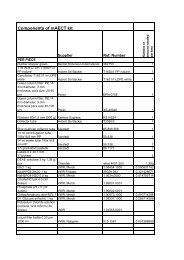
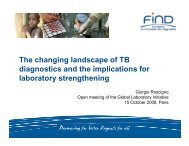
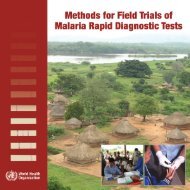
![Download in English [pdf 2Mb] - Foundation for Innovative New ...](https://img.yumpu.com/49580359/1/184x260/download-in-english-pdf-2mb-foundation-for-innovative-new-.jpg?quality=85)

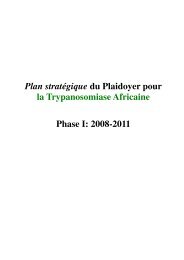
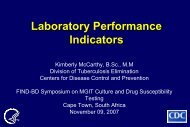
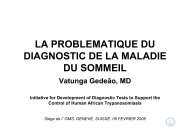
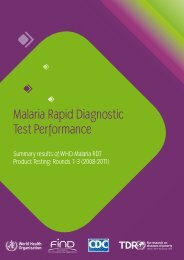
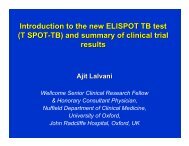
![New laboratory diagnostic tools for tuberculosis control [.pdf]](https://img.yumpu.com/43339906/1/190x135/new-laboratory-diagnostic-tools-for-tuberculosis-control-pdf.jpg?quality=85)
